History of our Stained Glass
“Church windows of stained glass…” this phrase conjures up an image of beautiful, dark, richly colored pieces of glass, which, when soldered together, tell stories from the Bible; stories as old as time itself. This has been the traditional focus of stained glass in the church. In contrast, Christ the Redeemer Lutheran Church chose to use stained glass to symbolize the spiritual journey that we, as children of God, travel. The beautiful windows throughout the Sanctuary and the Gathering Space portray the essence of our love and devotion to the Trinity, the deep meaning of the sacraments, and the specific missions to which CRLC’s members are called. The windows also capture the spirit and intent of this particular place of worship by highlighting the building’s placement on land of great natural beauty and serenity.
In the Chancel
These nature themed windows all depict flowers mentioned in the bible.
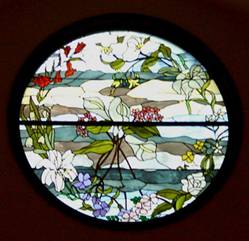
The round Chancel window was dedicated on May 26, 1991. The focal point of the window is the lily, symbolic of the purity of Christ and considered to be the flower of the Resurrection, surrounded by various flowers mentioned in scripture and native to the Holy Land.
CALLA LILLY: Lillium Candilum – The focal point of the window is the Lily, symbolic of the purity of Christ. Pure white leafless stems, reaching to the heavens. It is considered to be the flower of the Resurrection… “Consider the lilies of the field, they neither oil nor spin, yet I tell you even Solomon in all his glory was not arrayed like one of these.” Matthew 6:28
TRILLIUM: Trillium Grandiflorum – Symbolic of the Trinity – three Divine Persons in one God: Father, Son and Holy Spirit. Blooms in the spring “when the robin starts to sing.” Also called Wakerobin.
MADONNA LILY: Lillium Candilum – Symbolic of Chastity, Purity, and Etherial Beauty. Lily of the Bible…"My beloved is mine and I am his. He feedeth among the lilies." Son of Solomon 2:16
STAR OF BETHLEHEM, DOVE’S DUNG: Simbellatum Ornithoglum – Prolific white spring blossoms resemble the droppings of doves. The flower grows abundantly in Palestine. Cab, Hebrew unit of dry measure, approximately 1 pint…"And the fourth part of a cab of dove’s dung for five pieces of silver." II Kings 6:25
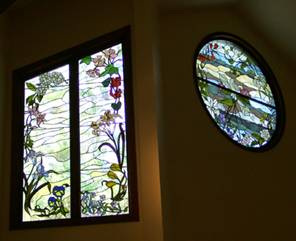
The two side panel windows were dedicated on May 12, 2002 and depict flowers which carry meaningful symbols, such as the Trinity, the wounds of Christ, Jacob's ladder, stems in the shape of the Cross, and precious oils which were used to honor Jesus.
"Then Mary took a pound of ointment of spikenard, very costly, and anointed the feet of Jesus.” —John 12:3
ROSE, CHRISTMAS ROSE, LENTEN ROSE: Helleborus – Blooms in the late fall to early spring. Often appears when the snow is on the ground, hence the name Christmas Rose.
MUSTARD SEED: Brassica Nigra – A familiar sight along the shore of Gallilee, where Jesus spoke to multitudes. Compare the fast growth of the Gospel message to the large development from a seed to a tree… "It is like a grain of mustard seed which a man took and cast into his garden, and it waxed into a great tree." Luke 13:19
JACOB’S LADDER: Polemonium Reptaus – Flowers in the spring and early summer. Leaves have many lance-shaped leaflets, and are arranged on the stems like the rungs of a ladder.
MADONNA LILY: The focal point of the window is the Lily, symbolic of the purity of Christ. Pure white leafless stems, reaching to the heavens. It is considered to be the flower of the Resurrection… “Consider the lilies of the field, they neither oil nor spin, yet I tell you even Solomon in all his glory was not arrayed like one of these.” Matthew 6:28
In the Gathering Space
Windows Over the Interior Entrance Doors

As we enter and exit God’s holy house, the two sacraments of Baptism and Communion are symbolized over the doors as a continued and enduring reminder of the promises of God’s saving presence. The shell signifies rebirth, and represents a tool that has sometimes been used to pour water over the person being baptized. The sheaves of wheat and cluster of grapes represent the bread and wine of Holy Communion. We believe in Christ’s real presence in this holy meal: in, with, and under these earthly elements. The large window, depicting a stylized world encircled by two doves, represents our mission as we leave worship: “Go in Peace, Serve the Lord.”
“Therefore go and make disciples of all nations, baptizing them in the name of the Father and of the Son and of the Holy Spirit, and teaching them to obey everything I have commanded you. And surely I am with you always, to the very end of the age.” —Matthew 28:19, 20

Worship
The enduring and constant presence of the Holy Spirit is symbolized by the dove in flaming colors of Pentecost.
“As soon as Jesus was baptized...heaven was opened, and he saw the Spirit of God descending like a dove and lighting on him. —Matthew 3:16
"When the day of Pentecost came, they were all together in one place...They saw what seemed to be tongues of fire that came to rest on each of them." —Acts 2:1-3
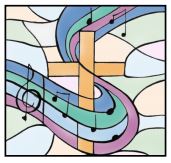
Music
The melodic score enfolding and uplifting the Cross symbolizes the never-ending depth of humble thanksgiving and praise that is expressed through both the beauty of the liturgy and the songs and psalms in our worship.
“I will praise your name, oh God, in song; I will proclaim your greatness with thanksgiving.” —Psalm 69:30
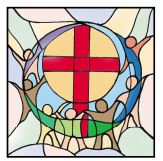
Fellowship
The stylized figures of people of different colors, encircling the cross, symbolize the ongoing Christian community of faith gathering to enjoy, nurture, support and affirm one another.
“If we claim to have fellowship with Christ yet walk in the darkness, we lie and do not live by the truth. But if we walk in the light, as he is in the light, we have fellowship with one another, and the blood of Jesus, God's Son, purifies us from all sin.” —1 John 1:6, 7

Serving
Recalling Jesus' servant act of washing his disciples’ feet prior to the Last Supper, this window represents service with humility.
“Now that I, your Lord and Teacher, have washed your feet, you also should wash one another’s feet. I have set you an example that you should do as I have done for you…Now that you know these things, you will be blessed if you do them.” —John 13:14-17

Christian Education
The lamp and the Bible are depicted as lighting the way to faith formation and Christian education.
“Your word is a lamp to my feet and a light for my path.” —Psalm 119:105
"When Jesus spoke again to the people, he said, "I am the light of the world. Whoever follows me will never walk in darkness, but will have the light of life." —John 8:12

Property
The ministry of property maintenance is represented by a depiction of our beautiful outdoor chapel. It reminds us that we are to care for the Lord's house as well as the world in which it resides.
"By the grace God has given me, I laid a foundation as an expert builder, and someone else is building on it. But each one should be careful how he builds. For no one can lay any foundation other than the one already laid, which is Jesus Christ." —I Cor. 3:10-11
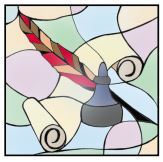
Communication
The ancient tools of communication, represented by the feather quill, inkwell, and scroll, are symbols that remind us of Martin Luther as he struggled to define and communicate his doctrines to the Christian community. Today we are called to be communicators of Christ's teachings.
“Oh, that my words were recorded, that they were written on a scroll, that they were inscribed with an iron tool on lead, or engraved in rock forever! I know that my Redeemer lives, and that in the end he will stand upon the earth.” —Job 19:23-25

Evangelism
The Chi Rho graphic of the cross has been used as a logo by CRLC for many years. The Christian hands reaching to others symbolize our call to go and tell others about Jesus and his promise of everlasting life.
“Then the disciples went out and preached everywhere, and the Lord worked with them and confirmed his word by the signs that accompanied it.” —Mark 16:20
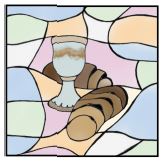
Wine and Bread
The cup of wine and loaf of bread are age-old symbols of both the Last Supper and the Sacrament of Communion. Specific to our church is the depiction of the ceramic chalice used in many of our Communion services today.
“Take and eat; this is my body.” Then he took the cup, gave thanks and offered it to them, saying, "Drink from it, all of you. This is my blood of the covenant, which is poured out for many for the forgiveness of sins.”
—Matthew 26:26-28
In the Sanctuary

Wine and Bread
The cup of wine and loaf of bread are age-old symbols of both the Last Supper and the Sacrament of Communion. Specific to our church is the depiction of the ceramic chalice used in many of our Communion services today.
“Take and eat; this is my body.” Then he took the cup, gave thanks and offered it to them, saying, "Drink from it, all of you. This is my blood of the covenant, which is poured out for many for the forgiveness of sins.”
—Matthew 26:26-28
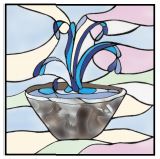
Fountain of Water
The fountain of water in the earthenware bowl is a symbol of eternal life, as mentioned by Jesus. This depiction is a mirror of our ceramic bowl used in the Sacrament of Baptism at CRLC.
“Jesus answered, “Everyone who drinks this water will be thirsty again, but whoever drinks the water I give him will never thirst. Indeed, the water I give him will become in him a spring of water welling up to eternal life.” —John 4:13, 14

Thanks to ...
The gift of these beautiful, inspirational stained glass windows was made possible by the many generous donations to the CRLC Memorial Fund. For more details regarding the donors to this fund, please see the Memorial Gifts Book which is located in the Narthex. If you wish to contribute to this fund, please see the staff for more details.
Poremba Stained Glass Studio, Inc. was responsible for the beautiful workmanship of the windows. Details about this company can be obtained on their website: www.porembastudio.com.
